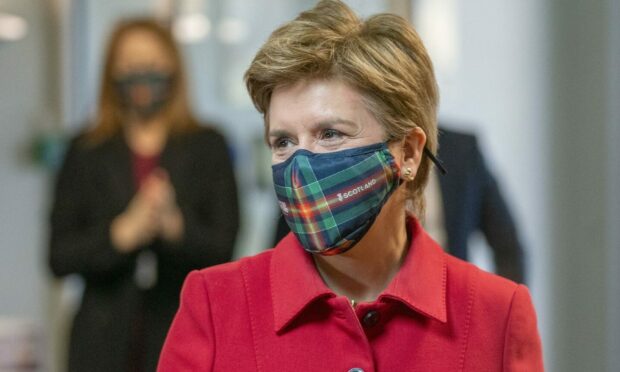Nicola Sturgeon says Scotland is now “through the worst” of Omicron, as she announced a route map out of tougher Covid restrictions would be published later this month.
At her weekly coronavirus update the first minister said Scotland is starting to see a new decline in the number of people being admitted to intensive care and the number of people dying from coronavirus.
In the past week, the number of patients being admitted to hospital with coronavirus fell from 682 to 550.
The number in intensive care has fallen from 70 at the end of January to just 31.
But as the figures appear to stabilise, here is everything you need to know about the latest response to the pandemic in Scotland.
1. When will restrictions end?
The answer should be clear on February 22.
That is when the Scottish Government plans to publish its new coronavirus framework, which will set out Scotland’s roadmap out of the pandemic.
Ms Sturgeon says it will help Scotland to “manage Covid more sustainably and less restrictively in the remaining phases of the pandemic and as the virus hopefully becomes endemic”.
Although we don’t know what will be detailed in the plan, the first minister says vaccination will be a key part.
MSPs will debate and vote on this new plan when they return after the February break at Holyrood.
In the meantime, restrictions such as wearing face coverings and the use of vaccine certificates remain in place.
2. Do children still need to wear face masks in school?
For now, yes.
In the run-up to this week’s coronavirus briefing there were numerous calls from opposition parties for the need for secondary school pupils to wear face coverings in the classroom to be dropped.
However, Ms Sturgeon says an advisory subgroup on this issue is meeting this afternoon, and says the government will consider any advice the subgroup gives.
Any changes to this rule are not likely to come in until after the February half-term holidays.
This comes after a backlash against proposals to chop the bottom off classroom doors to help improve ventilation in schools.
Education Secretary Shirley-Anne Somerville said the response has been a “wilful misunderstanding”.
But Conservative MSP Tess White said: “She cannot seriously try and claim there was a wilful misunderstanding of the proposals when Nicola Sturgeon defended them in parliament last week.”
3. Young people are bearing the brunt
Cases have declined by 5% in the last week, from around 7,400 a day to just over 7,000.
But infection rates have more than doubled in the 16-24 year old age group.
This is despite case numbers falling in the under 15s, the 25-44 year olds, and in the over 75s.
Today, 6,630 more people have tested positive for #coronavirus
950 people were in hospital yesterday which is 8 fewer than the day before.
Sadly 14 more people who tested positive have died (10,447 in total)
Latest update ➡️ https://t.co/bZPbrCpok5 pic.twitter.com/CZmQr37eAX
— Scottish Government (@scotgov) February 8, 2022
The first minister says it was “always likely” there would be some increase in infection because of the recent change in guidance allowing people to go back to working in their offices.
4. Should we be worried about the new Omicron subtype?
A new subtype of the Omicron variant called BA2 is circulating in Scotland.
The number of confirmed cases of BA2 has risen from 26 to 103.
Ms Sturgeon said this is likely a significant underestimate of the true figure.
This is because the BA2 infection is identified by genomic sequencing, which does not happen on all tests.
In parliament, Ms Sturgeon said: “What is encouraging is there is no evidence the disease caused is any more severe than that caused by the main Omicron variant, nor does it appear to be more capable of evading the immunity conferred by vaccination or prior infection.”
5. Sturgeon’s plea to follow the basics
The Office for National Statistics says the prevalence of coronavirus in Scotland is now one in 30.
Ms Sturgeon repeated a plea for people to take lateral flow tests before meeting up with other people, to wear face masks and to get their booster vaccine.
The Scottish Government is also launching a new marketing campaign to encourage more people to get their booster vaccine, with the first minister saying it could be “the difference between life and death” if you contract the virus.


